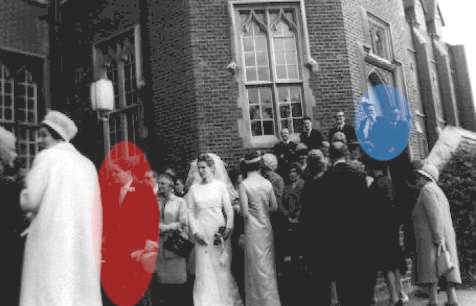IJVS Volume 3 Edition 5 - editorial
![]()
I first ran into Bob “Jake” Jacobsen in the mid 1960’s when I was a Post-doc with the late Ellis Lippincott at the University of Maryland in College Park. I was there for the summers of 1964 and 1966 and met up with many wonderful people including Peter Klaboe, Derek Steele and Linda and Malcolm Whatley. I got to know Jake at the Maryland Vibrational Spectroscopy Summer Schools and at Conferences. I was immediately drawn to his polite, easy-going manner combined with first-class ability. Jake was one of the most pleasant gentlemen I have ever met – I mean it, a real gentleman in the best sense of the word.
In September 1966, I returned from the States and two weeks later married my lady wife Janette. Jake and Bill Fateley were in London at the time and came to the festivities.

Jake and Bill are at the top right of the picture.
You will notice that Bill looks a good deal younger than he does now – the Bridegroom has hardly changed! Patrick – How have you managed to keep your svelte figure? – Louise[who would also like to point out that she was only 18 months old at the time!]
I kept up with Jake when I visited the States and last worked with him a few years ago in Seattle where we both lectured on the vibrational spectroscopy of bio-systems – Jake covered the use of mid infrared and I spoke about Raman.
Jake and Bill somehow acquired a slide of our wedding photograph and for years whenever one of them turned up at a Conference at which I was a speaker, a rogue slide would mysteriously get included in my set. Usually in the MIDDLE! Solution – use overheads!
About a year ago, we decided to dedicate an Edition of IJVS to the memory of Dr Bob Jacobsen and to highlight the work in which Jake was most involved in the latter part of his career – the use of infrared spectroscopy in studying biological systems. To my delight Kai Griebenow agreed to edit this important edition. Kai’s review is quite honestly, in a class of its own – please read it – you will be sampling, I am sure, a keynote article.
Editor
It is my pleasure to introduce this special memorial issue to Dr Bob Jakobsen of the Internet Journal of Vibrational Spectroscopy at the end of the year 1999 and on the brink of a new century. Quite amazing are the advantages that have appeared in vibrational spectroscopy, particularly in the last 20 years when Fourier-techniques have been applied to spectral acquisition and data analysis. ‘Jake’, who this issue is being dedicated to, has contributed significantly to this process. The regular editor of IJVS, Patrick Hendra, has taken on the task of describing these contributions.
I do not consider myself a vibrational spectroscopist. The truth is that I am a scientist who uses whatever method is available to characterize biological systems. However, many of my scientific works have made extensive use of the power of Raman- and FTIR-spectroscopy.
Based on this, I started thinking about what makes both spectroscopic methods so appealing in the characterization of complex biological systems. One possible answer is that both can be applied under a variety of conditions that are not easily accessible by other spectroscopic methods. Secondly, they can be applied non-invasively. This is what this issue focuses on.
Sockalingum et al. describe the application of surface enhanced FT-Raman spectroscopy (SERS) to study the interactions of drug and target molecules in living cells. Novel concepts are described in this exciting paper (both instrumentally and conceptually) allowing insight into drug-target interactions with tremendous potential in the area of drug development and testing.
My own group contribute a mini review on the use of FTIR spectroscopy in the development of devices for the sustained release of pharmaceutical proteins from biocompatible polymers. The strength of the spectroscopic method consisted here in the possibility to investigate samples in very different states (amorphous protein powders, suspensions, and dispersions in the polymer matrix) in combination with the non-invasive character.
The other three contributed articles in this issue use FTIR spectroscopy. Gao and Ci describe the use of FTIR spectroscopy to characterize breast tissue samples. They found significant spectral differences between benign and carcinoma tissue. The findings may become important in the future to further the diagnosis of the disease on the biochemical rather than morphological level.
Sertsou, Agatonovic-Kustrin and Rades offer a paper in pharmaceutical analysis field and in Section 4 Nagasaki and co-workers describe a fascinating application of computer power to FTIR instruments.
I hope you find pleasure in reading the above-mentioned articles, which provide a small insight into the growing world of vibrational spectroscopy applications in biological systems.
Kai Griebenow
